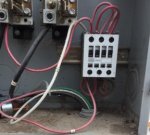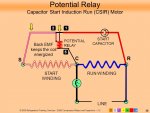ptonsparky
Tom
- Occupation
- EC - retired

Problem: Blown start cap. As in paper everywhere. Don’t see that often.
Replaced all caps being sure to not screw up. One of new blew. It will be going to the motor shop but when I started removal this is what I found in the fused disconnect. The small red that comes from the left lug hits all three of the line side of the contactor plus it jumps back to one side of the coil. Bottom lugs go to #7 of the motor lead. Single phase 15 hp. White going to other side of coil wire comes from #2 motor lead.
I suspect this a home made start switch replacement by a motor shop. Any SEWAG?
No wiring diagram on the motor and IDK the MFG although i do have picture of nameplate.


